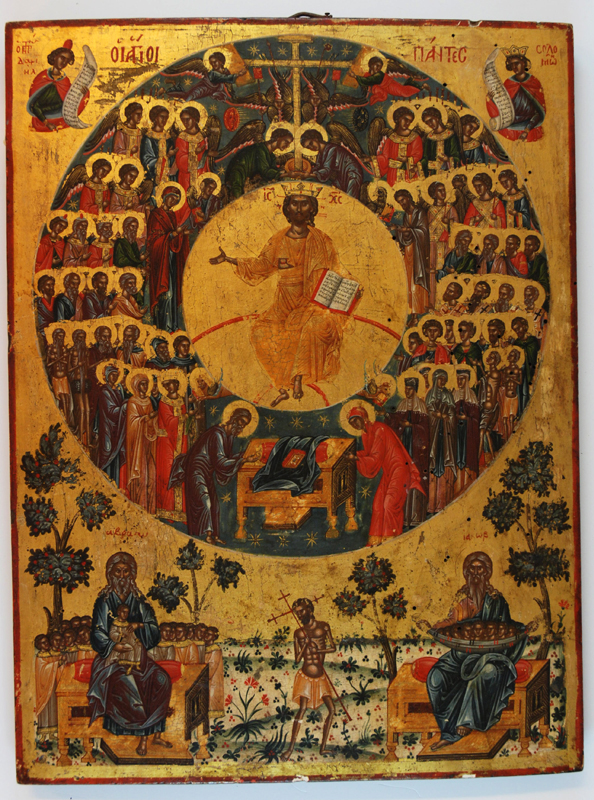When I set out on a trip, I usually consult Google Maps on my phone. To find directions to the place where I want to go, I input my current location then type in my destination. My starting point is always located at one specific address that differs from the endpoint address, because it is physically impossible to be present in two places at once. I cannot be both here and there at the same time.

In the spiritual life, however, this is not so. I attend the Divine Liturgy with other parishioners at a Denver-area church on a physical street. At the same time, we are participating in the ongoing worship in heaven. A local parish might be in Tulsa, London, or Sydney, but the Divine Liturgy occurs in the Kingdom of God. As we worship, we are in two places at once—physical reality and heavenly reality. Here and there at the same time.
Location, Location, Location
![]()
The Apostle Paul reminded the Christians in Ephesus that God “raised us up together, and made us sit together in the heavenly places in Christ Jesus” (Eph. 2:6). This spiritual understanding does not fit into our earthly categories of space and time.
In his article “Heavenly Worship” (www.protomartyr.org), Fr. Richard Ballew writes, “Although heaven is invisible to the earthly dimension, it cannot be separated from the earthly dimension…. In a mystery, the two move on together, with the heavenly circumscribing the earthly. This is why the ascended Lord describes Himself in the Book of Revelation as the ‘One Who walks in the midst’ of the Churches (Rev. 1:7). If the Son of God were limited to heaven by time and space, how could He still be walking in the midst of His Church after His ascension? Furthermore, if God the Son is confined to heaven, why did He comfort His disciples by saying, ‘Lo, I am with you always, even to the end of the age’?” (Matt. 28:20).
Our location exists in both seen and unseen realities, and our fellow worshipers include both those we can see—the people standing in the nave, the altar, and the narthex—and those we cannot see. Our traveling companions are more numerous than the men, women, and children who surround us.
Angelic Visitors
As we ascend to heaven in the Divine Liturgy, our hymns and prayers take place among the angels who perpetually worship before God’s throne. This joint worship is especially apparent in the Trisagion Hymn. (Trisagion is Greek for “thrice holy.”)
With the words “Holy God, Holy Mighty, Holy Immortal, have mercy on us,” we proclaim the holiness of God three times in supplication, just as the angels do in Isaiah 6:3 (“Holy, holy, holy is the Lord of hosts; / The whole earth is full of His glory!”) and in Revelation 4:8 (“Holy, holy, holy, / Lord God Almighty, / Who was and is and is to come!”). As we sing, we unite with the heavenly hosts in this ongoing praise of the Triune God.

Sometimes God allows people to see the angelic presence in their midst. Elisha, facing a massive Syrian army, told his servant, “Those who are with us are more than those who are with them,” and through his prayers, the young man’s eyes were opened. He saw that “the mountain was full of horses and chariots of fire all around Elisha” (2 Kings 6:16-17).
In the fourth century, according to an article by Fr. Gregory the Hieromonk, St. John Chrysostom spoke of “an incident with a priest who witnessed a large number of angels clothed in bright robes luminous like the sun. He said he was carried up to the altar offering their help, bowing their heads in great respect, and then surrounding the Holy Table. At times they stood in silence, and others chanted liturgical hymns along with the chanters uplifting their melody.”
Often during a service, I watch the clergy and servers in the altar and think about the angels invisibly present. The liturgy itself reminds us of them when we sing of the Eucharist, “By angelic hosts invisibly / escorted by angelic hosts / Alleluia.”
What if my eyes were opened, allowing me to see the angels in the altar? Honestly, I think I would fall facedown on the floor in terror, causing a bit of a dramatic disruption to the service. Maybe this is why God hasn’t granted me such a gift.
Yet these attending angels comprise only part of the unseen worshippers in our midst.
Family Reunion
The saints, our brothers and sisters who have already entered the heavenly Kingdom, are also gathered with us in worship. In Hebrews 12:1, St. Paul notes that we are surrounded by a “cloud of witnesses,” referring to his earlier list of Old Testament greats. Then, toward the end of the chapter, he reminds us that we “have come to Mount Zion and to the city of the living God, the heavenly Jerusalem, to an innumerable company of angels, to the general assembly and church of the firstborn who are registered in heaven, to God the Judge of all, to the spirits of just men made perfect, to Jesus the Mediator of the new covenant” (vv. 22-24).

“It would be difficult to mistake what is happening here, would it not?” Fr. Richard writes. “The Church on earth is actually stepping into the heavenly dimension for worship. The Lord is present as are the saints and the angels—the entire host of the Church in heaven. What an array!”
It is easy to forget this unseen element of worship, especially when we are busy corralling preschoolers and stifling yawns during an early service. Yet even today God sometimes removes our blinders. A friend of mine entered her empty church and heard the faint melodies of a choir singing. Another woman saw a monk at the candle stand. When she looked again, he was gone—a glimpse of heavenly reality, serving as a reminder in the midst of her earthbound concerns.
Most of us will not see and hear heavenly visitations. Instead, we will experience the usual distractions as well as moments of prayerful peace as we journey through the Liturgy. I have attended Vespers and Compline services with only one other person attending. But as Fr. Lawrence Farley notes, “the building is still thronged with multitudes of the heavenly hosts” (Let Us Attend: A Journey through the Orthodox Divine Liturgy, 28).
Our entry into the nave is a step into the eternal present. As we participate in the Divine Liturgy, may we remember that we never travel alone.
Sister Lynette,
What a beautiful reminder of the beauty of worship! How this understanding and spiritual vision would impact the attitude, the response, the submission, the participation when we gather to worship the Lord!
Thank you for reminding me that I am “surrounded by such a great cloud of witnesses.”
Blessings to you and keep on writing!
Pastor Jeff